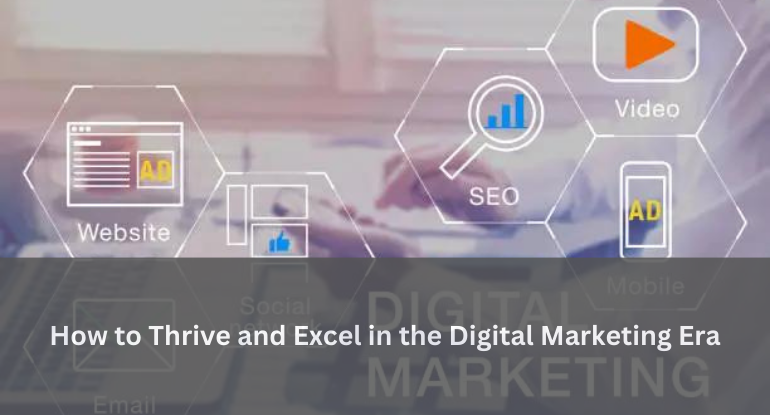
How to Thrive and Excel in the Digital Marketing Era
The landscape of marketing has evolved significantly in the digital age, presenting both immense opportunities and challenges. In this fast-paced, technology-driven era, traditional marketing strategies alone are no longer sufficient to keep businesses ahead of the curve.
Adapting and excelling in the digital marketing era requires a strategic approach and a deep understanding of the digital ecosystem.
In this blog post, we'll explore essential tips and strategies that can empower individuals and businesses to not only survive but thrive in the dynamic world of digital marketing.
From leveraging social media to mastering content creation, optimizing for search engines, and understanding data analytics, we'll delve into the key pillars of success in today's digital marketing landscape.
Let's discover how you can elevate your marketing game, reach a broader audience, and achieve unparalleled success in this ever-evolving digital realm.
Whether you're a seasoned marketer or just starting your journey, this guide will equip you with the knowledge and insights you need to flourish in the digital marketing era.
Understand Your Audience

Understanding your audience is the bedrock of a successful digital marketing strategy. This initial step sets the tone for all your marketing efforts. Your audience isn't a monolithic entity; it's a diverse group of individuals with varying preferences, behaviors, and backgrounds.
Conducting thorough market research is akin to shining a spotlight on this audience, revealing essential insights that will inform your marketing decisions.
#1. Comprehensive Market Research
Begin by delving into extensive market research. This involves analyzing data, studying industry trends, and comprehending the competitive landscape.
Investigate what your competitors are doing and how their target audience is responding. Uncover gaps in their strategies that you can leverage to differentiate your approach.
#2. Identify Preferences and Behavior
Next, focus on understanding the preferences and behaviors of your target audience. What do they like? What problems are they trying to solve?
How do they typically interact with digital platforms? Gathering data on these aspects will allow you to tailor your marketing strategies accordingly.
#3. Demographic Insights
Demographics provide critical insights into the diverse characteristics of your audience. Age, gender, location, income level, education, and occupation all play significant roles in shaping consumer behaviors. Understanding these demographics helps in creating marketing campaigns that resonate with specific groups.
#4. Tailor Marketing Strategies
Once armed with a deep understanding of your audience, tailor your marketing strategies to meet their unique needs and expectations.
Develop a personalized approach that speaks directly to them. Craft your messaging, visuals, and offers in a way that resonates with their preferences and motivates them to engage with your brand.
#5. Personalization is Key
Personalization is key to capturing audience attention and fostering brand loyalty. Utilize the data gathered from your research to personalize interactions with your audience.
Address them by their names, recommend products based on their past behavior, and tailor email campaigns to suit their preferences. This personal touch creates a stronger connection and enhances the likelihood of conversions.
#6. Create Compelling Content and Campaigns
Armed with insights into your audience's preferences and behaviors, focus on creating compelling content and campaigns. Craft content that speaks to their pain points, aspirations, and interests.
The goal is to establish an emotional connection that makes your audience more inclined to engage and take desired actions.
Understanding your audience forms the foundation of a successful digital marketing strategy. It guides every decision you make, ensuring your efforts are effectively targeted and resonate with the people you aim to reach.
The digital landscape is ever-evolving, so ongoing audience analysis is vital to adapt and refine your strategies for optimal results.
Leverage Social Media
Social media has emerged as a powerhouse for connecting with a wide-ranging audience and establishing meaningful engagements with potential customers. These platforms offer a dynamic space to showcase your brand and create a community around it.
To fully leverage this potential, it's essential to craft a robust social media strategy that aligns seamlessly with both your brand identity and the preferences of your target audience.
#1. Understanding the Platform Landscape
Each social media platform possesses unique features, demographics, and engagement styles. Familiarize yourself with these nuances and tailor your approach accordingly.
For instance, LinkedIn might be ideal for B2B interactions, while Instagram or TikTok might be better suited for visual and creative content. A tailored strategy ensures your message is delivered effectively on the platform where your target audience is most active.
#2. Creating a Consistent Brand Voice
Consistency is key to establishing a strong brand presence on social media. Develop a clear and consistent brand voice that reflects your brand's values, personality, and messaging.
Whether it's a witty, humorous tone or a more formal and informative approach, maintaining this consistency across all platforms and content types helps in reinforcing your brand identity.
#3. Crafting Engaging Content
Engaging content is the heart of any successful social media strategy. Tailor your content to resonate with your target audience. Share captivating visuals, informative articles, compelling videos, and interactive polls or quizzes.
Experiment with different content formats to understand what captivates your audience best and adjust your strategy accordingly.
#4. Interactive Engagement
Encourage interaction and engagement from your audience through interactive posts. Pose questions, conduct polls, or create contests that spark conversations. Respond to comments promptly and thoughtfully.
Acknowledge both positive and negative feedback, showing your audience that you value their opinions and are committed to providing excellent customer service.
#5. Leveraging Influencer Partnerships
Collaborating with influencers in your industry can significantly amplify your reach and credibility. Identify influencers whose followers align with your target audience. Partner with them to promote your products or services, leveraging their influence to introduce your brand to a broader audience.
#6. Timely Responses and Customer Service
Timeliness is crucial in the digital realm. Respond promptly to comments, messages, and inquiries. A quick and helpful response not only enhances the user experience but also demonstrates your dedication to customer satisfaction. Address concerns and resolve issues in a professional and timely manner.
#7. Analyzing and Iterating
Regularly analyze the performance of your social media efforts using analytical tools provided by the platforms. Evaluate metrics like engagement rates, reach, click-through rates, and conversions. Use these insights to fine-tune your strategy, optimizing your content and approach for better results.
A well-crafted social media strategy is a powerful tool to establish a strong online presence and foster meaningful connections with your audience.
By consistently delivering engaging content, interacting actively, and staying attuned to the evolving social media landscape, you can nurture a loyal following and drive valuable traffic to your website, ultimately contributing to your brand's success.
Optimize for Search Engines (SEO)

Search Engine Optimization (SEO) holds immense significance in ensuring that your website attains a favorable position on search engine results pages (SERPs).
This strategic approach involves a series of practices aimed at enhancing your website's visibility and accessibility to search engine algorithms, ultimately driving organic traffic to your platform.
#1. Understanding the Essence of SEO
SEO is a dynamic process that involves understanding the algorithms of popular search engines like Google, Bing, and Yahoo. It's about aligning your website's content and structure with the criteria these search engines use to rank pages.
By doing so, you increase the likelihood of your website appearing on the first page of search results, which significantly impacts user traffic.
#2. Conducting In-depth Keyword Research
Keyword research is the cornerstone of any effective SEO strategy. By delving into the minds of your potential audience, you can identify the specific words and phrases they use while searching for products, services, or information related to your business. These keywords then form the basis for optimizing your website's content.
#3. Optimizing On-Page Elements
Optimization involves strategically integrating these keywords into your website's content, meta descriptions, headings, and subheadings. This helps search engines recognize the relevance of your content to specific search queries, thereby improving your ranking for those keywords.
- Content Optimization: Incorporate keywords naturally within the body of your content. Ensure that the content is informative, engaging, and aligned with the expectations of your target audience.
- Meta Descriptions: Craft enticing meta descriptions using relevant keywords. These brief snippets provide a preview of your webpage and play a vital role in attracting users to click through to your site.
- Headings and Subheadings: Use keywords in your headings and subheadings to create a clear and organized structure for your content. This not only aids in SEO but also enhances the readability of your content.
#4. Regularly Updating and Enhancing Content
Search engines favor websites that provide fresh, valuable, and up-to-date content. Regularly update your website with new articles, blog posts, or multimedia content related to your industry.
This showcases your expertise and dedication to delivering current, relevant information, which, in turn, boosts your site's credibility and visibility in search results.
SEO is an ongoing endeavor that demands consistent monitoring, adaptation, and evolution. By investing time and effort in understanding the dynamics of SEO, conducting thorough keyword research, and optimizing your website accordingly, you position your platform for improved visibility and a broader reach, ultimately enhancing your online presence and success.
Invest in Content Marketing

Content stands as the undisputed monarch. The substance and quality of the content you produce wield immense power in shaping your brand's perception and reach.
It's a dynamic tool that, when wielded skillfully, can significantly impact your online presence and engagement with your audience.
#1. Understanding the Pinnacle Position of Content
Content marketing involves creating, curating, and sharing valuable, relevant, and consistent content to attract and engage a well-defined target audience. It's a strategic approach that focuses on building a strong rapport with your audience by offering them content that addresses their needs and interests.
#2. Crafting High-Quality and Informative Content
The core of content marketing lies in producing high-quality content that's not only engaging but also informative and valuable. Quality content is like a magnet that draws your audience in, captivating their attention and holding it.
Whether you're crafting blog posts, creating videos, designing infographics, or recording podcasts, the emphasis should be on providing content that educates, entertains, or solves problems for your audience.
#3. Showcasing Expertise and Authority
Content serves as a platform to showcase your expertise and position your brand as an industry authority. When you consistently produce content that displays your in-depth knowledge, experience, and understanding of your niche, you establish credibility.
This, in turn, cultivates trust among your audience, making them more likely to turn to your brand when seeking information or solutions.
#4. Driving Traffic and Encouraging Conversions
Compelling and valuable content acts as a catalyst for driving traffic to your website or platform. When your audience finds your content valuable, they are more inclined to share it with others, exponentially increasing your reach.
Moreover, informative content can guide potential customers through their buyer's journey, nudging them towards a conversion — whether it's making a purchase, signing up for a newsletter, or filling out a contact form.
Content marketing is a perpetual journey of creating, distributing, and managing valuable and relevant content to attract and retain a clearly defined audience.
By investing in creating top-notch content that resonates with your audience and aligns with your brand's objectives, you not only amplify your brand's visibility but also foster a stronger relationship with your audience, thereby propelling your business towards sustainable growth and success.
Utilize Email Marketing

Email marketing continues to be an influential and highly effective strategy for nurturing leads, engaging with prospects, and fostering lasting relationships with customers.
It provides a direct channel of communication with your audience, allowing you to deliver personalized, targeted messages effectively.
#1. The Potent Power of Email Marketing
Email marketing involves sending tailored messages to a carefully curated list of recipients, aiming to convey valuable information, promotional offers, or updates related to your products, services, or brand.
It's a strategy that, when executed thoughtfully, can yield substantial results in terms of customer retention, brand loyalty, and conversions.
#2. Building a Targeted Email List
The foundation of effective email marketing is a well-curated email list comprising interested prospects and existing customers. Strategically build this list by encouraging website visitors to subscribe to your emails, offering incentives or gated content in exchange.
Ensure that these individuals have shown genuine interest in your brand, products, or services, as this increases the likelihood of engagement and conversions.
#3. Personalization and Relevance in Email Content
One of the key strengths of email marketing is the ability to personalize content for each recipient. Craft your emails in a way that resonates with the recipient, addressing them by their name and tailoring the message based on their preferences and past interactions with your brand.
Provide relevant information, exclusive promotions, or updates that align with their interests, ultimately enhancing engagement and fostering a sense of individualized attention.
#4. Crafting Targeted and Compelling Emails
Segment your email list based on various factors such as demographics, purchase history, or engagement levels. This segmentation allows you to craft targeted emails that are specifically tailored to each group.
Whether it's a special discount for a recent website visitor or product recommendations based on past purchases, relevance in your emails increases the likelihood of engagement and conversion.
#5. Analyzing Email Metrics for Optimization
After sending out your emails, closely analyze key email metrics such as open rates, click-through rates, conversion rates, and unsubscribe rates. Use these insights to understand how your audience is interacting with your emails.
Identify patterns, preferences, and areas for improvement. Fine-tune your strategies based on these analyses to optimize your future email campaigns for better engagement and ultimately, higher conversions.
Incorporating email marketing into your digital marketing strategy allows you to establish direct, personalized communication with your audience. By building and nurturing a targeted email list, delivering relevant and engaging content, and utilizing email analytics for continuous improvement, you can harness the true potential of email marketing to nurture leads, retain customers, and drive conversions.
Embrace Data Analytics

Embracing data analytics is akin to tapping into a goldmine of invaluable information. It's a powerful tool that equips marketers with the ability to understand, analyze, and leverage data to enhance their strategies, drive informed decisions, and achieve optimal results in their campaigns.
#1. The Essence of Data Analytics
Data analytics involves employing specialized tools and techniques to collect and interpret data related to user behavior, website traffic, and the performance of marketing campaigns.
This data can encompass a range of metrics such as click-through rates, conversion rates, user demographics, geographic locations, and more. Analyzing this data provides profound insights into the efficacy of your marketing efforts.
#2. Utilizing Analytics Tools for In-Depth Insights
Marketers have a plethora of sophisticated analytics tools at their disposal. These tools gather a vast amount of data, which can be categorized and analyzed based on various parameters.
They provide an in-depth understanding of how users interact with your website, respond to your campaigns, and navigate through your digital assets.
#3. Gaining Insights into Effective Strategies
By delving into the data obtained through analytics tools, you can pinpoint what strategies are working well and resonating with your audience.
For example, you can identify which types of content garner the most engagement or which marketing channels are generating the most traffic. This knowledge is essential for refining and optimizing your marketing initiatives.
#4. Identifying Areas for Improvement
In addition to recognizing successful strategies, data analytics helps in pinpointing areas that need improvement. It highlights underperforming campaigns, poorly-performing website pages, or drop-off points in the user journey.
Armed with this information, you can strategize ways to enhance these aspects for better engagement and conversion rates.
#5. Making Data-Driven Decisions
Perhaps the most significant advantage of data analytics is its ability to facilitate data-driven decision-making. When armed with comprehensive and accurate data, you can make informed choices regarding marketing strategies, budget allocation, campaign adjustments, and more. This ensures that every decision is backed by evidence and is more likely to yield favorable outcomes.
#6. Continuous Optimization for Improved Outcomes
Data analytics doesn't end at just analysis; it's an ongoing process. Regularly monitor and analyze the performance of your marketing strategies.
Continuously optimize your campaigns based on the insights gained, adapting to the evolving preferences and behaviors of your audience. This iterative process helps you stay ahead of the curve and achieve increasingly improved results over time.
Stay Updated and Adapt
The digital landscape is constantly evolving, with new technologies and trends emerging regularly.
Stay informed about the latest developments in digital marketing, attend webinars, read industry blogs, and participate in relevant workshops. Adaptability is key; be ready to pivot your strategies to align with the changing digital landscape.
Conclusion
Thriving in the digital marketing era requires a combination of understanding your audience, leveraging the right platforms and tools, creating compelling content, and staying informed about industry trends.
By implementing these strategies and staying agile in your approach, you can excel in the digital marketing realm and achieve your business goals.